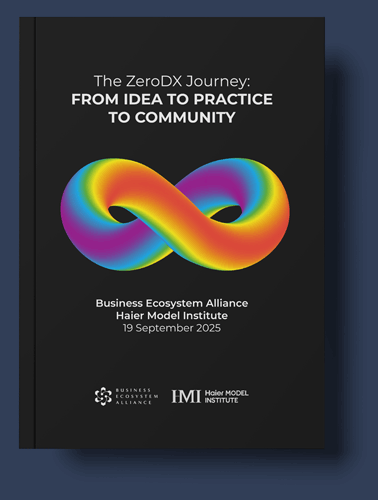
4D Systems (Australia)
Since 1990, 4D Systems has forged its place as a global leader for intelligent displays and graphics processors.
Now a 25-person organization, based in Minchinbury, New South Wales, Australia, 4D Systems, highlights key areas in which it embodies and practices the concept of Zero Distance. Its in-house management system drives responsiveness to user needs. This is called the "AKNAR Method": Agility, Knowledge, Network, Adaptability, Responsibility and allows each of the company’s departments to be inter-dependent. The company is modelled as an ecosystem, literally, rather than as a hierarchy. This covers the entire organization and includes the storage and management of data and which informs 4D’s human-centred design approaches. Because 4D is already structured as an ecosystem-modelled enterprise, co-creating and openness is embedded in its DNA.This is underpinned by its use of the servant-leadership framework. It has developed its own “4D Philosophy for Excellence". The cornerstones of this are the company’s suport for CSR and ISO26000 principles, as well as an abiding commitment to value accountability.

Gummy Industries (Italy)
Gummy Industries is a digital communication agency with 60 employees based in Brescia, Italy. It works on brand identities, marketing and digital strategies.
In 2021 the company divided itself into six micro-enterprises. These were labelled Kitchens. Each has a "Chef" who manages the micro-enterprise and is responsible for P&L. The Chef shares a percentage of the unit's margins with the whole team. There is a "general market", which offers services which are common to most kitchens: accounting, human resource management, marketing and sales development. Already one of the micro-enterprises has spun off from Gummy. Flatmates, an influencer marketing business, is now an independent company.
Making this work revolves around the concept and practice of Zero Distance. The kitchen teams are very small and there is no internal hierarchy. Everybody in the team is able to talk to the client directly. This means that Gummy Industries can listen closely to client needs and implement new services and new ways of working as and when required. Every kitchen is able to define the scope of its work and to pick freely the kind of service it wants to provide. They have the freedom to be very different in their behaviour and culture than the main company.

ABM Industries (USA)
There is an innovation website for team members which showcases how barriers have been broken down and fosters an innovative and collaborative ecosystem. It uses an open-sourced approach to finding and solving user challenges (both for internal employees and front-line workers, as well as external clients and partners). The site allows anyone to submit an idea that they think would solve an issue they face individually or on a larger systemic level. Through this, ABM ensures that those experiencing the problems are also active contributors to developing potential solutions.
ABM utilizes project teams which are built on independence, collaboration and being able to move quickly to solve challenges. A transparent, publicized criteria for green-lighting ideas to move forward —focused on feasibility and value — is leveraged to ensure that team members understand how solutions are prioritized. As critical user needs are identified, team members are supported with resourcing and guidance to move them forward to pilot and, where viable, scaled solutions. And, ABM has a centralized digital platform that configures and makes data accessible which enables the systematic collection, storage, and use of end-user data to increase value for end users.

Kofax (USA)
With 2,000 employees, the Irvine, California-based intelligent automation software company Kofax believes that while Zero Distance responsiveness requires bottom-up employee engagement, company boards and management teams must act as ambassadors to drive the concept forward. Kofax makes this possible by inspiring purpose in work—every employee can see the connection between their energy spent and the impact on the customer. From a management perspective, this begins with establishing objectives and key results, followed by functional responsibilities matched to initiatives. This holds everyone in the organization accountable to deliverables.
A customer advisory board in three primary world regions is tuned into discovering customer expectations and how Kofax will deliver. With over 25,000 customers in financial services, insurance, government, healthcare, supply chain, business process outsourcing and other markets, this represents a sizeable task and investment of time and resources. A total of 850 global partners provide additional feedback. A newly created growth function monitors the voices of customers, partners, market analysts and data while ensuring alignment on transformational initiatives, backed by executive level commitment.

Brandwatch (Denmark)
This peer-to-peer learning was echoed in the launch of Brandwatch Community: an online portal for users to engage and learn from each other.
Brandwatch also introduced a product roadmap process, gathering broader and earlier feedback from commercial teams to inform product development. It formalized a voice-of-the-customer program, headed by the Director of Customer Insight, and placed this function within the strategy office to ensure it could work across departments. This formed a customer-centricity guild: a working group of stakeholders from all departments in the business, and has helped define new customer personas now shared across the organization.

Teladoc Health (USA)
Teladoc Health, based in Purchase, New York with 5,000 employees around the globe, was founded on a simple, yet revolutionary idea: everyone should have access to the best healthcare anywhere in the world on their terms. Teladoc Health has been focused on the healthcare consumer, the end user, from the start. Real-time data and feedback loops, targeted AI-selected nudges, integration across devices, and digital engagement combine to provide an ambient healthcare environment that ensures patients have continuous access to doctors and care.
Teladoc incorporated design thinking into every level of the organization so new solutions can launch quickly and continuously adapt to meet consumer needs. To move toward Zero Distance, it invested in learning programs focused on consumers and strategic innovation. Employees have access to leadership, product roadmaps, and design blueprints to provide input and break down barriers. Among many eye-catching initiatives and best practice, the company reorganized its entire product and engineering organization into platform teams with end users in mind.
Most recently, teams within Teladoc Health R&D came up with a new internal name to better identify who they are: “BEACONS,” which stands for Bold Experts Advancing Clinical Outcomes & Novel Solutions. This name gave the different functions within the department a shared understanding and focus that they were one unified team working together to design and build services that serve the customers of Teladoc Health.

Chorus (Australia)
Chorus provides home and community care for elders and people living with disability and mental illness in Western Australia. With 550 people, it has created a model to support the organization’s purpose: enabling people to live the life they choose. “The intent behind major changes happening at Chorus boils down to three words: Local, Simple, Effective,” says CEO Dan Minchin. Chorus has radically decentralized to relational, empowered and integrated local teams. This counters the trend of care services to become transactional, bureaucratic and commercialized. Each local operation delivers several care services, partners with people in the neighbourhood and local organizations, and takes accountability for the end-to-end customer and employee experience as well as business performance. This means that local people need to develop the competencies and culture to deal with matters previously reserved for managers, such as coordination, conflict, performance management, service delivery and business development. Chorus is also transforming the "enabling" organization to support the local level. It has eliminated most management layers, sustaining the organization with a people/tech platform for core processes and to foster learning, compliance, decisions and growth. In place of managers, it has coaches who work with people to achieve their goals.

Typefi (Australia)
Established in 2001 on the Sunshine Coast in Queensland, Australia, Typefi initially launched with the vision of providing automated publishing software for print documents that would enable collaborative workflows within workgroups and across enterprises. It delivered the world’s first fully automated desktop publishing system in 2004 and now helps content creators automate the layout of complex documents at speed without compromising design. Expanding to North America and then to Europe, Typefi is now an established global leader in single-source, multi-format automated publishing, with customers in over 20 countries and a team of 46 staff across eight countries.Typefi’s flat organizational structure empowers employees by removing the middle man. Utilizing asynchronous communication, it has opened direct lines between end-users and the heart of the company. Backed by their peers, Typefi engineers confidently prioritize customer issues on the fly, knowing their code is a vital piece in the success of the customer and company. Typefi approval ratings are consistently above 90 percent and rarely does a customer ever leave after implementation. Typefi’s customer success team embodies the Zero Distance principles—designing a team culture that’s user-focused, built on collaboration and trust, and driven by an honest desire to see all parties succeed.

Coalescent Mobile Robotics (Denmark)
An Odense, Denmark-based, robotics company that designs and builds agile, fast and smooth collaborative robots (Cobots) in order to assist the retail industry, Coalescent Mobile Robotics believes that humans and robots can coexist in the workforce. The English word coalesce comes from the Latin coalescere meaning, “to unite, to grow together or to become one in growth”, and the company champions culturally diverse people being united to design and build agile, fast and smooth Autonomous Mobile Robots (AMRs) to address specific retail challenges. “For us, Zero Distance means to be barrier-free, to think of our customers as our partners and friends. We like to keep our end users close, so they can at all times make the most of our robotics solutions. We’ve had constant interaction with our end users from the beginning of our development process, having discussions about new ideas and requests, so our product could be more responsive to their needs and create more value. We will continue to keep Zero Distance, it just creates a happier journey for everyone!" says founder and CEO Clionadh Martin. The company, which now has 15 employees, provides a unique robotic solution to automate warehouse-shop re-stocking through a fleet of mobile robots, assisting shop staff for more efficient operation.


